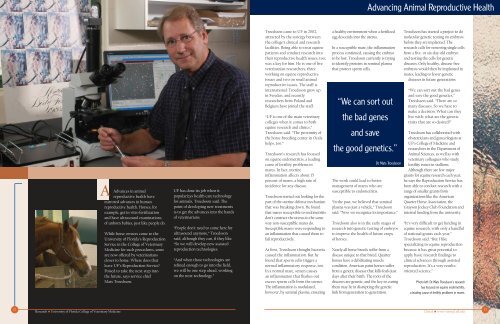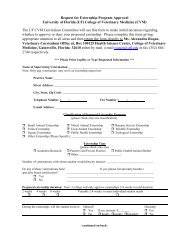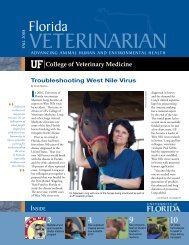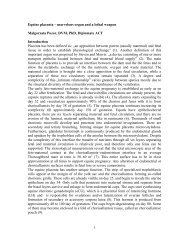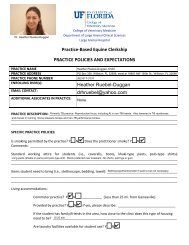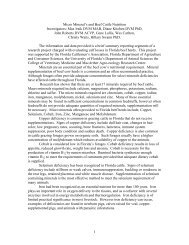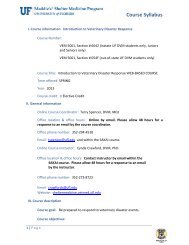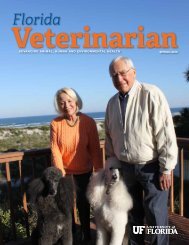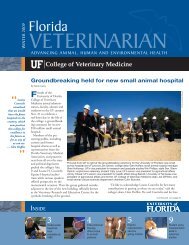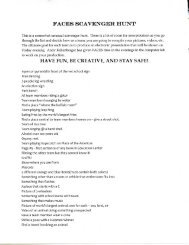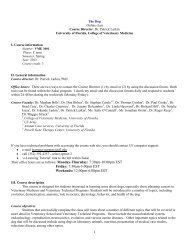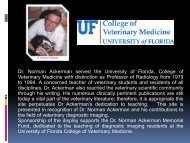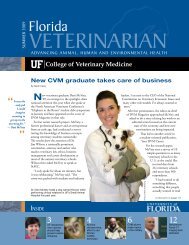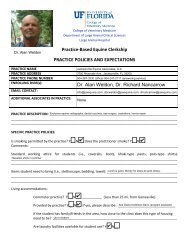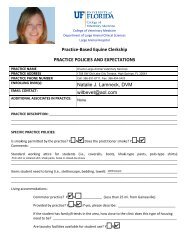College of Veterinary Medicine Research Brochure
College of Veterinary Medicine Research Brochure
College of Veterinary Medicine Research Brochure
- No tags were found...
Create successful ePaper yourself
Turn your PDF publications into a flip-book with our unique Google optimized e-Paper software.
Advancing Animal Reproductive HealthAAdvances in animalreproductive health havemirrored advances in humanreproductive health. Horses, forexample, get in vitro fertilizationand have ultrasound examinations<strong>of</strong> unborn babies, just like people do.While horse owners come to theUniversity <strong>of</strong> Florida’s ReproductionService in the <strong>College</strong> <strong>of</strong> <strong>Veterinary</strong><strong>Medicine</strong> for such procedures, someare now <strong>of</strong>fered by veterinarianscloser to home. Where does thatleave UF’s Reproduction Service?Poised to take the next step intothe future, says service chiefMats Troedsson.UF has done its job when itpopularizes health care technologyfor animals, Troedsson said. Thepoint <strong>of</strong> developing new treatmentsis to get the advances into the hands<strong>of</strong> veterinarians.“People don’t need to come here forultrasound anymore,” Troedssonsaid, although they can, if they like.“So we will develop new assistedreproduction technologies.“And when those technologies arerefined enough to go into the field,we will be one step ahead, workingon the next technology.”Troedsson came to UF in 2002,attracted by the synergy betweenthe college’s clinical and researchfacilities. Being able to treat equinepatients and conduct research intotheir reproductive health issues, too,was a key for him. He is one <strong>of</strong> fiveveterinarian-researchers, threeworking on equine reproductiveissues and two on small animalreproductive issues. The staff isinternational: Troedsson grew upin Sweden, and recentlyresearchers from Poland andBelgium have joined the staff.“UF is one <strong>of</strong> the main veterinarycolleges when it comes to bothequine research and clinics,”Troedsson said. “The proximity <strong>of</strong>the horse-breeding center in Ocalahelps, too.”Troedsson’s research has focusedon equine endometritis, a leadingcause <strong>of</strong> fertility problems inmares. In fact, uterineinflammation affects about 15percent <strong>of</strong> mares, a high rate <strong>of</strong>incidence for any disease.Troedsson started out looking for thepart <strong>of</strong> the uterine defense mechanismthat was breaking down. He foundthat mares susceptible to endometritisdon’t contract the uterus in the sameway non-susceptible mares do.Susceptible mares were responding toan inflammation that caused them t<strong>of</strong>ail reproductively.At first, Troedsson thought bacteriacaused the inflammation. But hefound that sperm cells trigger anormal inflammatory response, too.In a normal mare, semen causesan inflammation that flushes outexcess sperm cells from the uterus.The inflammation is modulated,however, by seminal plasma, ensuringa healthy environment when a fertilizedegg descends into the uterus.In a susceptible mare, the inflammationprocess continued, causing the embryoto be lost. Troedsson currently is tryingto identify proteins in seminal plasmathat protect sperm cells.“We can sort outthe bad genesand savethe good genetics.”The work could lead to bettermanagement <strong>of</strong> mares who aresusceptible to endometritis.Dr. Mats Troedsson“In the past, we believed that seminalplasma was just a vehicle,” Troedssonsaid. “Now we recognize its importance.”Troedsson also is in the early stages <strong>of</strong>research into genetic testing <strong>of</strong> embryosto improve the health <strong>of</strong> future crops<strong>of</strong> horses.Nearly all horse breeds suffer from adisease unique to that breed. Quarterhorses have a debilitating musclecondition. American paint horses sufferfrom a genetic disease that kills foals justdays after their birth. The roots <strong>of</strong> thediseases are genetic, and the key to curingthem may lie in disrupting the geneticlink from generation to generation.Troedsson has started a project to domolecular genetic testing on embryosbefore they are implanted. Theresearch calls for removing single cellsfrom a five- or six-day-old embryoand testing the cells for geneticdiseases. Only healthy, disease-freeembryos would then be implanted inmares, leading to fewer geneticdiseases in future generations.“We can sort out the bad genesand save the good genetics,”Troedsson said. “There are somany diseases. So we have tomake a decision: What can theylive with; what are the genetictraits that are so desired?”Troedsson has collaborated withobstetricians and gynecologists atUF’s <strong>College</strong> <strong>of</strong> <strong>Medicine</strong> andresearchers in the Department <strong>of</strong>Animal Sciences, as well as withveterinary colleagues who studyfertility issues in stallions.Although there are few majorgrants for equine research each year,he says the Reproduction Service hasbeen able to conduct research with arange <strong>of</strong> smaller grants fromorganizations like the AmericanQuarter Horse Association, theGrayson Jockey Club Foundation andinternal funding from the university.“It’s very difficult to get funding inequine research, with only a handful<strong>of</strong> national grants each year,”Troedsson said. “But I likespecializing in equine reproductionbecause it has great potential toapply basic research findings toclinical advances through assistedreproduction. It’s a very resultsorientedscience.”Photo left: Dr. Mats Troedsson’s researchhas focused on equine endometritis,a leading cause <strong>of</strong> fertility problems in mares.22<strong>Research</strong> • University <strong>of</strong> Florida <strong>College</strong> <strong>of</strong> <strong>Veterinary</strong> <strong>Medicine</strong>••Clincal • www.vetmed.ufl.edu23


